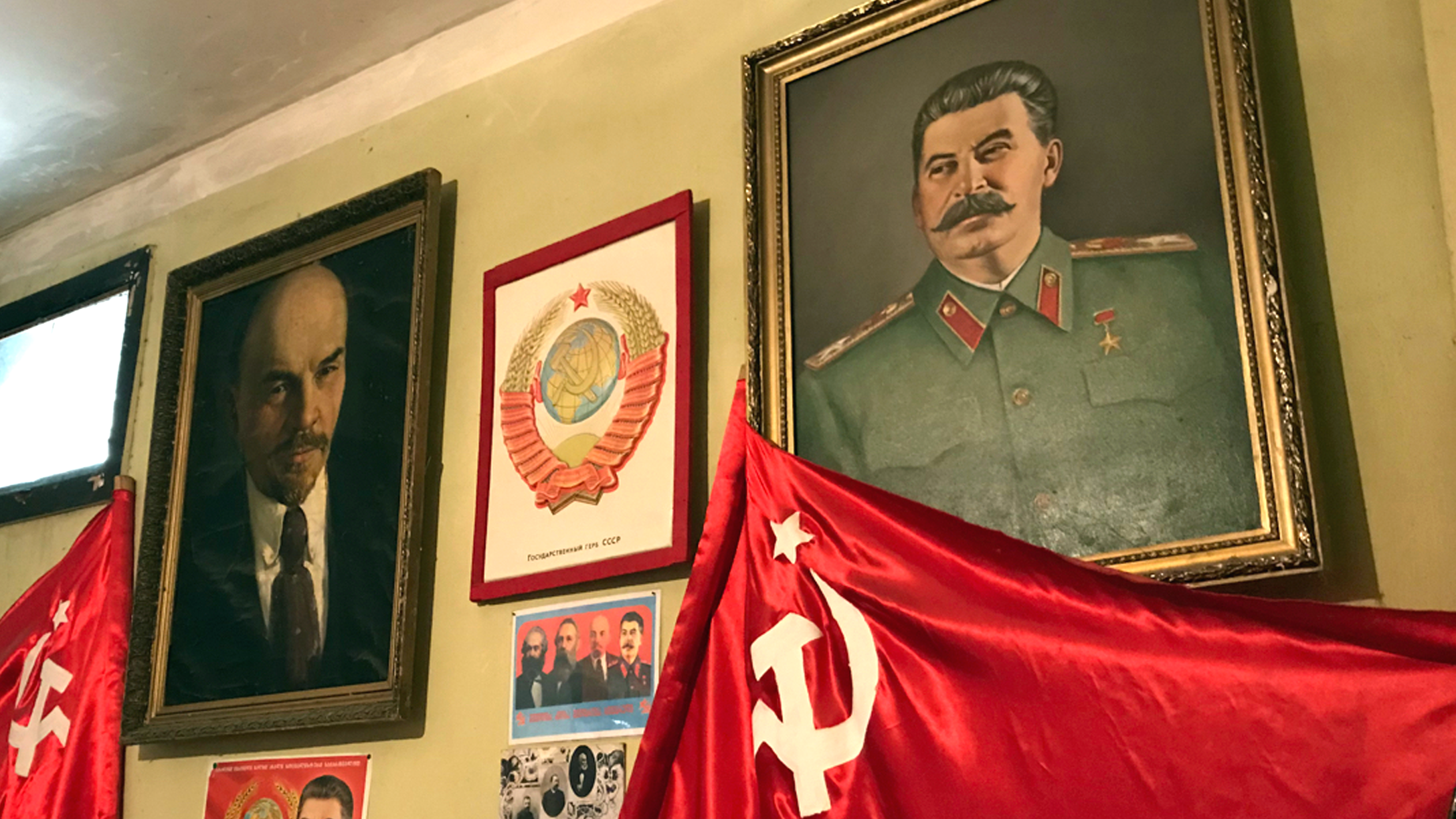I don’t think I had ever met what you could call an “unreconstructed Stalinist” before Zhiuli Sikmashvili, deputy chairman of the Communist Party of Georgia, and director of a museum in Tbilisi devoted to the country’s most infamous native son. A dwindling number of pilgrims visit this site, in a little compound built over an authentic Old Bolshevik relic — the rusted printing press the socialist underground ran before the Revolution, which has remained in place like a holdover from another world. It is a place that tries to describe the romance and magic of the start of Josef Stalin’s career, when he was just a dashingly handsome seminary dropout, poet, and anti-tsarist rabble-rouser, rather than the center of a swirl of mass murder and political terror around which so much of the 20th century would pivot.
I visited the museum on a bright and cold day last winter with my wife and daughter. My wife is a Russian-born sociologist, with a particular interest in the post-Soviet transition. We had heard about the press museum as a strange piece of surviving Soviet lore when we were in Georgia for a few weeks, and went on our own to see what it is about.
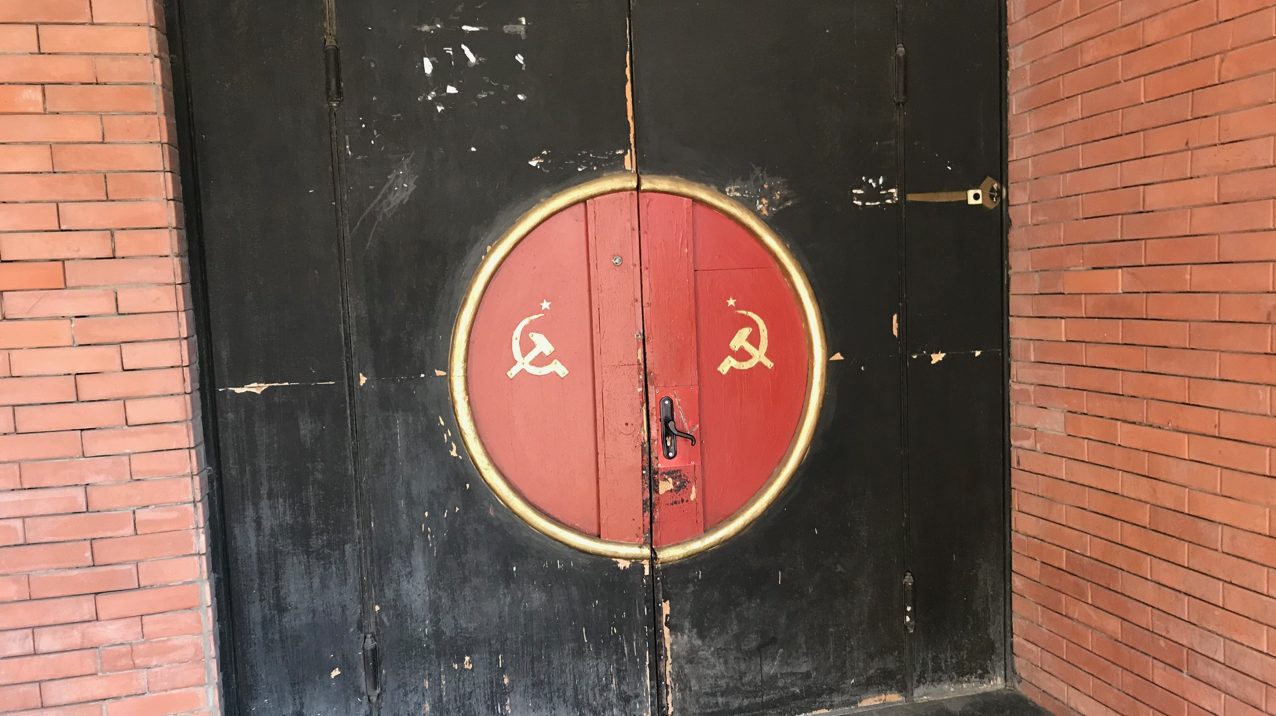 Christopher Marcisz
Christopher MarciszThe Museum of J. Stalin’s Underground Printing Press is on a quiet side street in the Avalbari neighborhood of the Georgian capital, in a nondescript brick office building with a bright red painted door with hammers and sickles near the door handles.
A radio was playing. The nearly empty building didn’t seem to be heated. We met Sikmashvili, who was wearing a thick wool coat and hat, in a space like a lost closet of the Revolution, with portraits of Lenin and Stalin and wartime posters and old Soviet maps on the wall, a desk covered with issues of Pravda, a few banners in the corner from past May Days and Victory Days. Georgians are justly proud of their hospitality, and he was eager to set aside what he was doing to talk, in Russian, with perhaps a few extra digs at NATO when he found out I was American.
For decades the press museum was one of the city’s biggest tourist attractions, a key spot for groups of Soviet tourists on carefully-planned trips. On his first visit as a schoolboy, Sikmashvili said, there was a three-hour wait, and at its peak in the 1970s about 800 visitors a day came through.
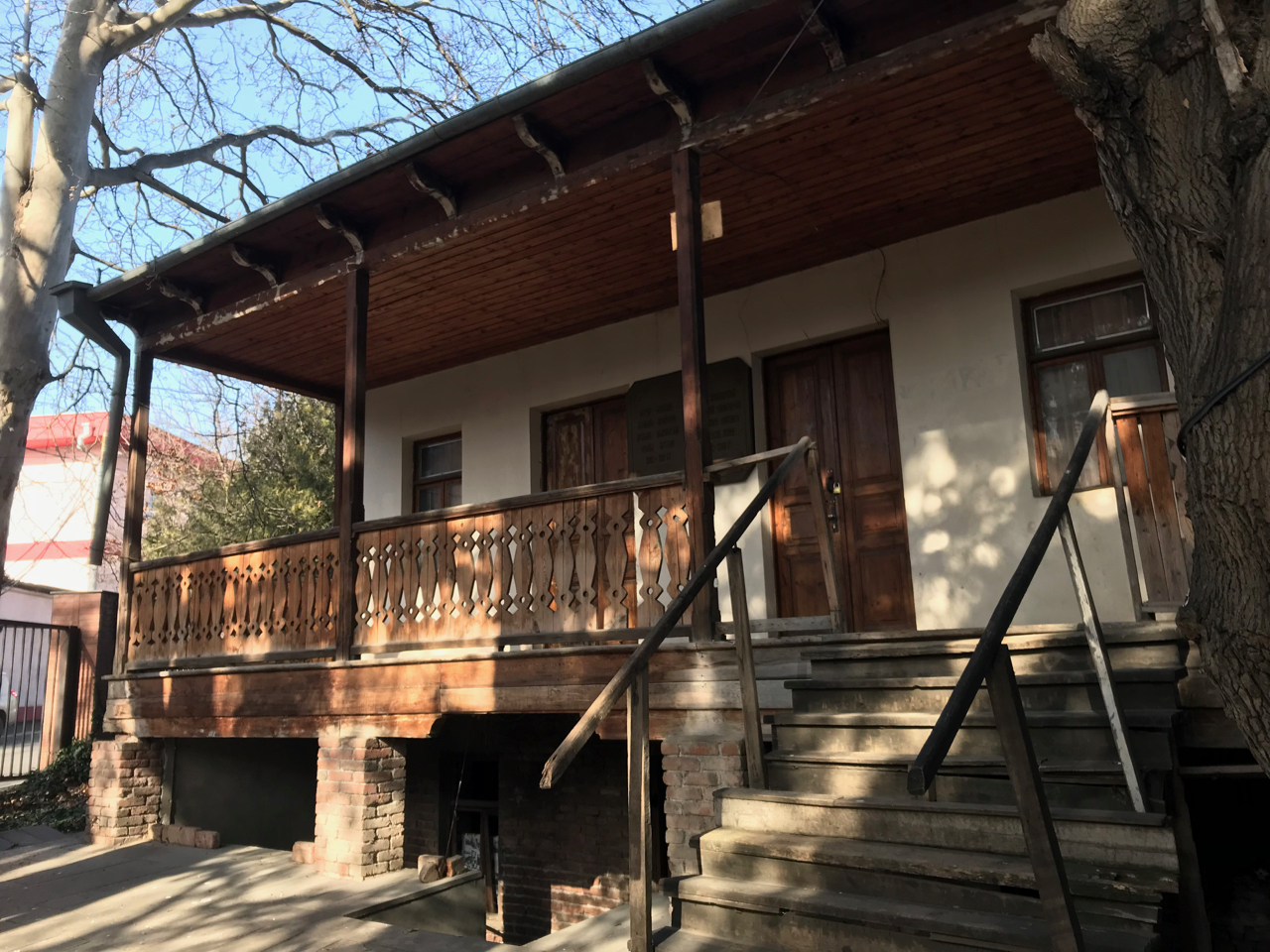 Christopher Marcisz
Christopher MarciszThis is certainly not the case today. He showed us around, my wife taking notes and helping translate the parts I couldn’t catch with my still-developing Russian. I was also trying to keep our eleven-year old engaged, by foregrounding the cops-and-robbers elements ahead of the ideology.
The first exhibit is about the gang of revolutionaries in imperial Tiflis as it was known at the start of the 20th century. In particular, it highlights the role of the rakish provincial lad named Iosef Vissarionovich Dzhugashvili, better known as “Sosa” to his family, “Koba” to his comrades, and “Soselo” to fans of underground leftist poetry. The exhibit is so frozen in time it feels like a museum of a museum, consisting mostly of images of various revolutionary committees, and of Tiflis back then. The city was a crossroads of the Southern Caucasus, on a railroad that connected Batumi on the Black Sea to Baku on the Caspian: an ethnically mixed and politically volatile place where a clever schemer like young Stalin could make a career.
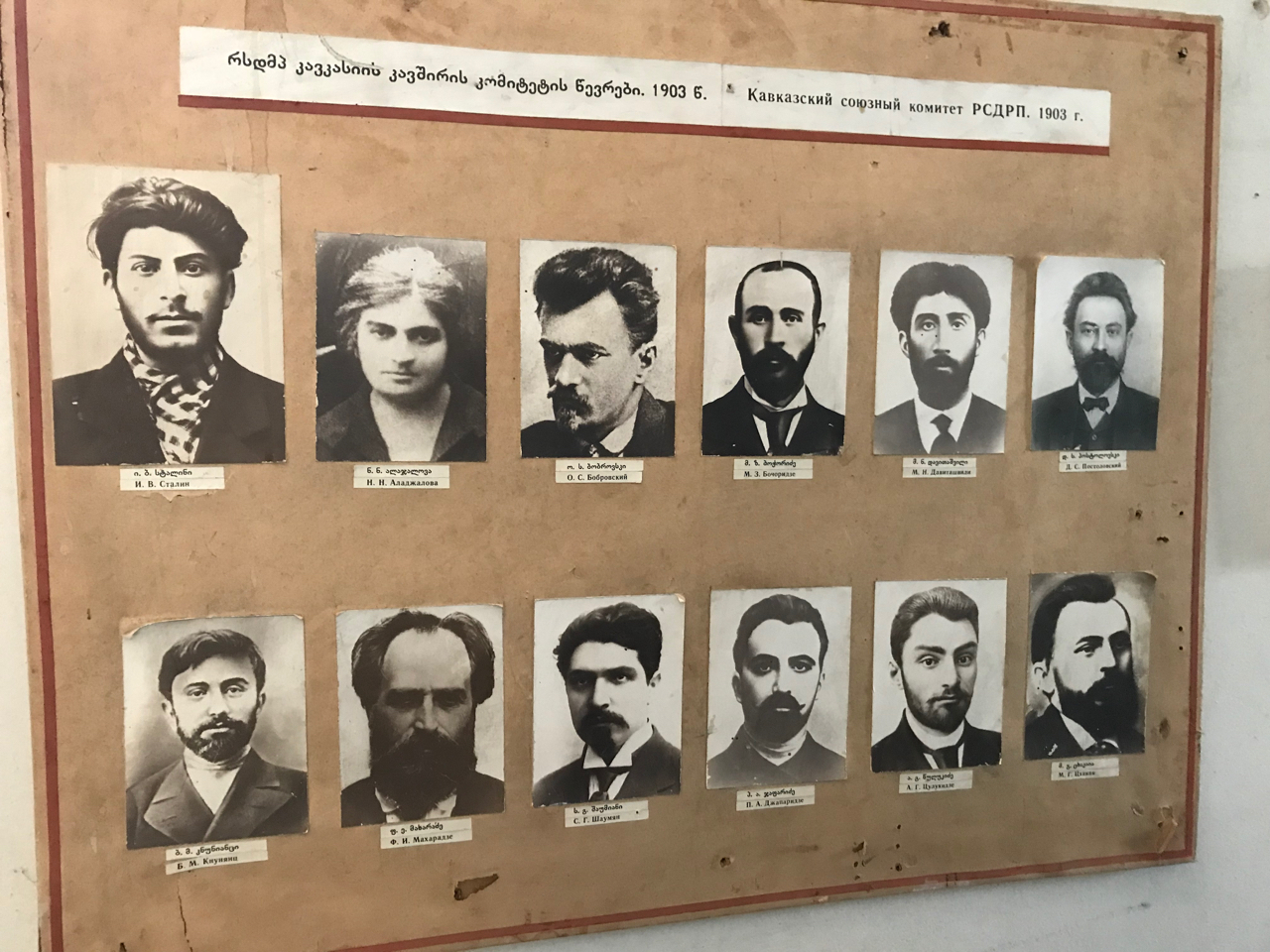 Christopher Marcisz
Christopher MarciszHe had fallen in with the Bolshevik wing of the socialist movement, which under Lenin’s leadership had split in 1903 from the more moderate socialists who favored an inclusive, gradual approach to social revolution in Russia in favor of a vanguard of professional revolutionaries who would force the issue. That life was one on the run — around the region as well as abroad to Vienna, Stockholm, London, and Tampere, as well as a few spells in prison in Russia’s Far North and Siberia. In Tiflis he ran the press, and masterminded a daring state bank mail coach robbery in 1907. The printing press ran various pronouncements in Georgian and Armenian from the socialist leadership, with commentary from Stalin and others, until they were betrayed by an informant and the authorities burned the house down.
Coming face to face with Soviet storytelling is always a bit of a shock. It happens every time we go back to Moscow, my wife’s hometown, where you’ll still see vestigial signs of Soviet times — sheaves of wheat on lamp posts, stars embedded on buildings, place names for old Soviet heroes. You get a sense that the thing you grew up fearing is still there, that time might be a flat circle.
It really isn’t though. Russia almost 30 years later may have a few of the same structures in place, but the motivations and identity of those holding power is different. And when it comes to Stalin, he manages to be everywhere and nowhere at once. There is still a fascination with power, and pride in how the Great Patriotic War turned out. While in the West he remains a reliable boogeyman for anti-leftist name-calling, at home it is more complicated.
And that becomes impossibly complicated in Georgia, where there is still a memory of him as an actual person, and there’s some pride in a local boy who went on to big things. At the craft market in the center of Tbilisi near the Dry Bridge along the Mtkvari River you’ll still find a lot of unironic images of a kindly, avuncular Stalin, usually holding a pipe with an inscrutable, knowing expression.
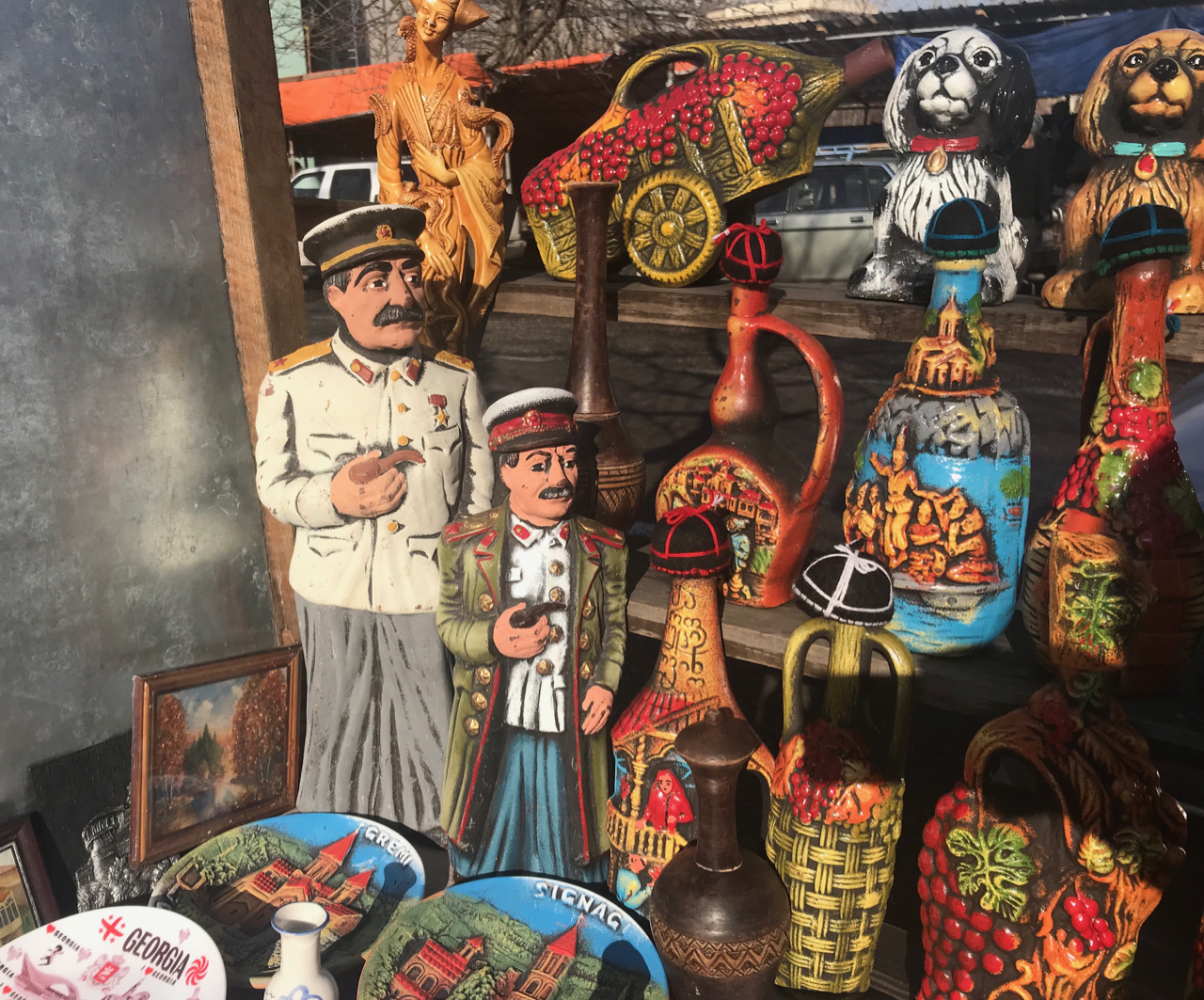 Christopher Marcisz
Christopher MarciszBut a porcelain figure that goes on a desk isn’t the same as a bronze statue in a public square. Georgia re-emerged as an independent nation in 1991, and endured years of corrupt rule by former Soviet apparatchiks, displaced in the early 00s by the aggressively westward-looking technocracy of Mikheil Saakashvili, which led to a disastrous short war with Russia in 2008. Power is now shared by a rotating cast of oligarchs, including one billionaire who lives in a Bond villain compound high on a hill visible from most of Tbilisi. And while some interesting bits of Soviet history exist in architecture, most other traces are gone, often replaced by right wing friends of Georgia.
Just blocks away from the press museum is a George W. Bush Street, and another named for the Russophobic late Polish President Lech Kaczynski.
The press museum is an island of grim consistency, which is remarkable considering how long and loud the arguments around Stalin have been. Library shelves strain to explain his variety of evil, to deflect blame onto the bureaucracy, to argue whether he is more or less evil than Hitler.
By his own design he was hard to pin down, but there are a few things that are agreed. You probably should forget the monosyllabic goon you saw in The Death of Stalin. Like many of the original Bolsheviks he was a voracious reader, who could quote favorites like Walt Whitman and James Fenimore Cooper. He was skilled at boiling down complex arguments to simple juxtapositions, with a catechism style formed in his seminary days; a skilled networker, who somehow managed to position himself just outside the most heated arguments, so everyone considered him a valuable ally. But there was never any doubt about his ideological conviction and practical ruthlessness.
That’s how he outlasted all other contenders after Lenin died in 1924, and created a superpower under his absolute control. What is most frightening about Stalin’s brand of authoritarianism is how deeply he bent reality on itself with self-contained logic and rules. How the revolutionary spirit was channeled into bureaucracy and state power. “Ideology was no longer a weapon,” wrote French thinker Guy Debord in the 60s, while trying to explore a third way between Soviet Communism and capitalism. “But a lie that can no longer be challenged becomes a form of madness. Eventually, both reality and the goal sought dissolve into a totalitarian ideology that proclaims that whatever it said was all there is.“
Subverting that totality was the work of uprooting Stalinism. First was the process of even settling on a set of statistics to describe what happened — an ongoing and still highly contentious project. By one set of figures, there were about 20 million victims, with perhaps one in eight Soviet citizens arrested. But there are other sets of figures. The near-meaninglessness of numbers so deeply twisted and falsified over so long a period transfers an enormous value onto the stories of individual lives.
More come at you every time you open a book or meet someone new. One I’ve been thinking a lot about lately comes from Adam Hochschild’s 1994 book An Unquiet Ghost. Hochschild had found Vladimir Glebov, the son of Lev Kamenev (one of Lenin’s most trusted comrades, and a founding father of the Soviet Union). Glebov was eight when his father was shot after one of the most notorious show trials, in the course of which he’d admitted all manner of absurd crimes against the state. After his mother was also shot, Glebov’s name was changed and he bounced from one Siberian orphanage to another.
He eventually earned a spot studying in Leningrad, where the NKVD privately warned him that he could do so only because they had forgotten about him, and he better stay that way. So he kept his head down and studied Balkan history, only to be arrested anyway, four years later. He was held without charge for nine months before the state labeled him an “aesthete” and gave him a ten-year sentence. He was released when Stalin’s successor Khrushchev began rehabilitating prisoners. When Hochschild found him at his home in Novosibirsk, Glebov was a retired college lecturer, quick with Stalin jokes, and a Marxist critic of the new capitalist order.
The assumption in the 1990s was that just telling the stories and ending the shame and silence around them would help heal. This has been the important work of Memorial, a non-profit organization that works to reclaim the stories of those repressed. But even that work is sometimes subsumed in the memory of the Great Patriotic War, now the subject of a public sense of victimhood—one that offers a clear, redemptive triumph.
Reading any account of Russia’s 20th century it feels like a miracle that anyone survived. Between the separate stories of individuals and the weight of millions lies the reality for most people, that even at the worst moment, seven in eight Soviet citizens were not arrested.
My wife has a photo that struck me when I first saw it. It shows her mother as a child; she’s sitting with her father on the balcony of their apartment on a warm day. She is smiling, he is laughing. The picture was taken in the late 1940s. The war was just a few years past, and like every other man in his generation he fought from start to finish in a conflict that led to the deaths of well over 20 million people. At that moment, the Cold War was just beginning, Stalin was at the height of his power, and a new round of repressions was in the offing, this one perhaps even more paranoid yet depressingly predictable: it would target Soviet Jews like them. But on that day on that balcony they were happy.
Even at the worst people carry on as they will, and laugh and love and make jokes. As Yuri Slezkine wrote in his sweeping book about the Soviet ruling elite at the time, The House of Government, a big part of the reason the Soviet Union failed — and failed so quickly, lasting not even the span of one person’s lifetime — was the multitude of contradictions present from the start that prevented the kind of totality the project required. The Bolsheviks couldn’t or wouldn’t extend the Revolution into family life, nor was there an emotionally resonant explanation for why their scientific certainty didn’t work as planned.
Over and over, they tried rewriting the story to recreate the magic. The press museum is one example of a monument of rewriting history—of sucking up. Biographers today note that Stalin was adept at many of the metaphysics of underground activity — jockeying for influence, claiming credit, groveling to the authorities, seducing his comrades’ wives — but there was no hint of what he would become.
In the early 1930s the Soviet chief in the Caucasus was Lavrenty Beria, who most likely saw that a lot of Old Bolshevik memoirs about the pre-revolutionary period were too honest, in that they didn’t give Stalin enough credit. So he set about reframing that period, turning Stalin’s hometown of Gori into a pilgrimage site, and in 1937 rebuilding the underground press’ safe house. It was a great career move for Beria, who in 1938 would move to Moscow to become the new head of the NKVD, where he would remain until Stalin’s death in 1953.
Back upstairs by the door there is a guestbook, refashioned out of an old trade union award book. Flipping through, most of the most recent entries are in Chinese. Sikmashvili said they get a handful of visitors from China every week and are eager to encourage more to stop by. The guestbook only goes back to 2015 because the original book is missing — Sikmashvili suspects the National Museum swiped it when it controlled the site for a few years in the 90s.
He also said that the reason the press had rusted so badly is that for years the cellar had flooded because of nearby construction. But a high-ranking Chinese general visited and was outraged by its condition and promised to bring it up at the embassy. Somehow the flooding stopped.
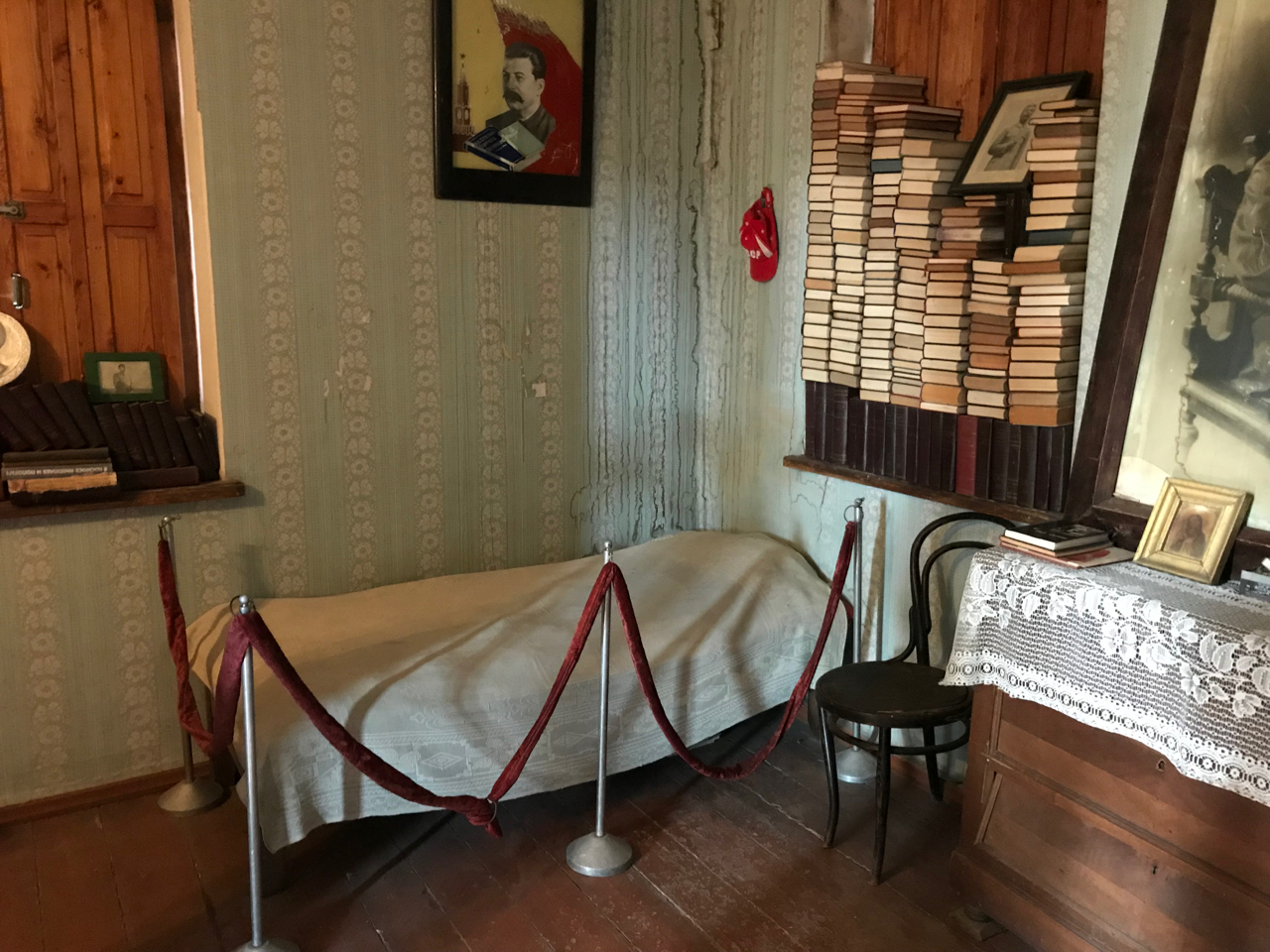 Christopher Marcisz
Christopher MarciszHe took us over to the restored safe house, which is modest and homey and full of odds and ends. There are stacks of books, portraits of Stalin, period furnishings including a bed surrounded by velvet ropes where the great man would have slept.
Stalin always had his fans; this Bolshevik theme park from the Great Terror remained open all the way through the end of the Soviet Union in 1991.
My wife always tells me stories of her parallel life growing up in the “Evil Empire.” The old order was dying — hers was the first generation that didn’t have to join Komsomol to get ahead — and also curious about the West. In America at the time, we learned that the Soviet people were unreasonable lunatics who lived in a prison camp and wanted to bury us. She learned that underneath the acrimonious rhetoric, all workers are brothers and sisters, though in capitalist countries they were blinded and shackled by their masters.
Getting away from the idea that we “won” the Cold War has been a big part of coming to understand Russia, for me. We spend a lot of time in Moscow with our family; our daughter has friends at her grandparents’ dacha outside the city. And it seems clear that nostalgia for the Soviet Union is less clear-cut than it is presented. Most people were interested in some kind of “freedom,” electoral democracy, national self-determination. But they didn’t want to give up access to health care or higher education in exchange for the remote possibility that a few of them might become insanely wealthy. They weren’t red-pilled by Ayn Rand novels or persuaded by Reagan’s sunny optimism. They wanted to live in a version of Finland, not the extreme winner-take-all hell that we’ve helped create.
Putin survives by channeling that sense of wounded pride, and there is still a small number of people like Sikmashvili who stay with what they think was working. They are quick to disregard the bad parts. When my wife asks Sikmashvili about the repressions, he waves it away and all but declares it “fake news.” Overblown, he says, although it is true there were enemies everywhere.
If there’s one thing I learned from Russia it is that hearing stories from relatives, reading the abundant history, meeting the true believers, is that all of us on the Left have to give a thought to Stalin, not just because the right makes us, but because there’s no denying the worst-case extremes. I’ve moved further left as I’ve grown angrier about the return of ethnonationalism and oligarchy, the inability of neoliberal technocracy to slow the polarization of wealth, the advance of climate change, the constant of race, gender, and class violence. But all that time aware that the more abstract the absolutes — whether tsarist autocracy, Stalin’s administrative terror, or free market maximalism — the more magical thinking it demands.
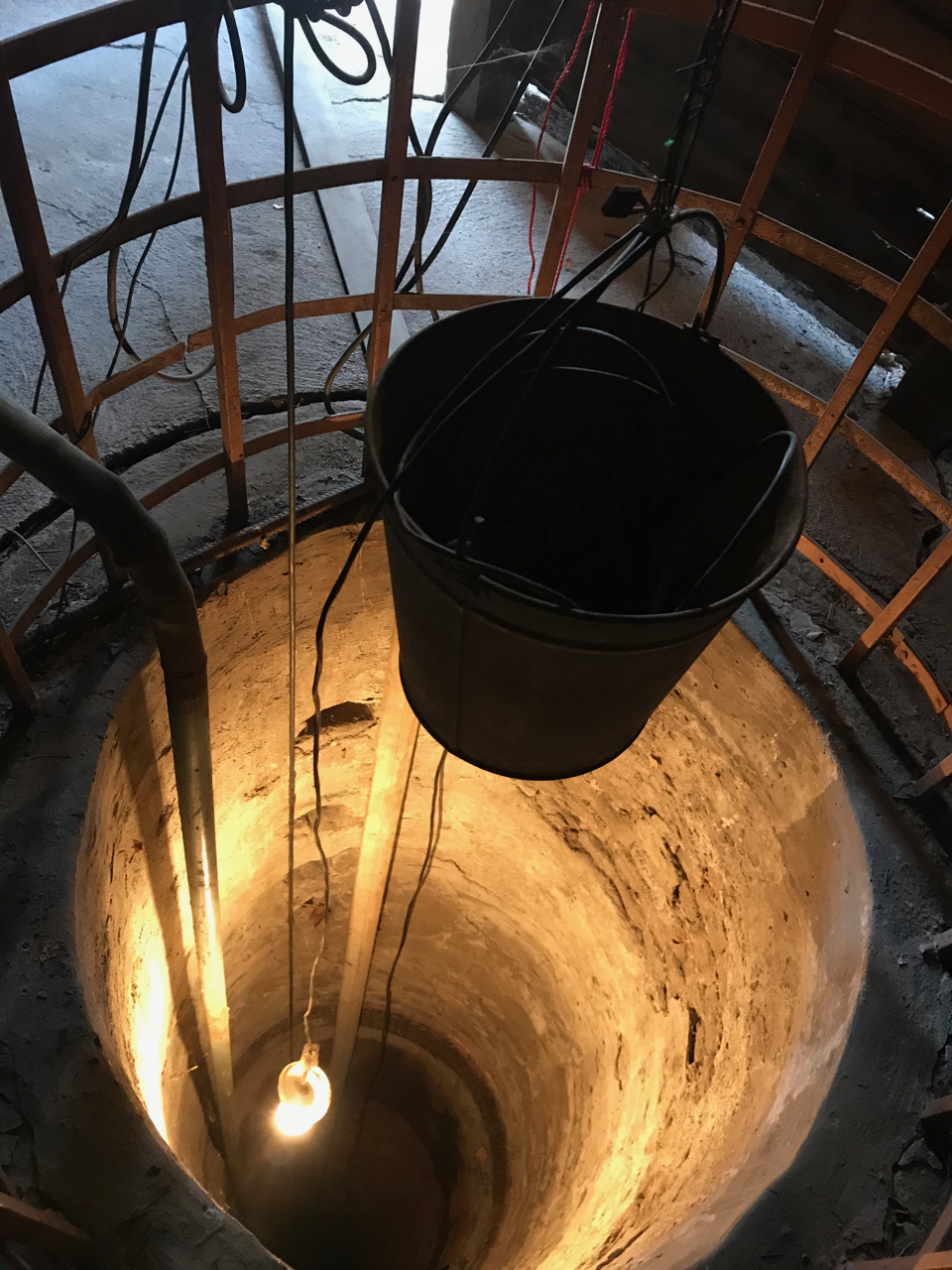 Christopher Marcisz
Christopher MarciszThe highlight of the museum, the most sacred space in this Bolshevik fantasy, is the little concrete bunker beneath the house where the press still rests. At the time, you had to access it by climbing down a well, though nowadays you can take a rusty spiral staircase down. The press was very loud, so there was a bell system rigged up to signal the printers — one ring for be quiet, two for all clear, and three rings to signal dinner was ready.
The bunker is a little concrete cellar lit by a single bare bulb. The press is a rusting hulk in the center, when you approach it you can see a few details — a label from 1893 — but it’s almost impossible to tell how it actually worked. The press is just a symbol of the power of the word, of freedom and expression where it struck out from the heart of one tyranny to create another.
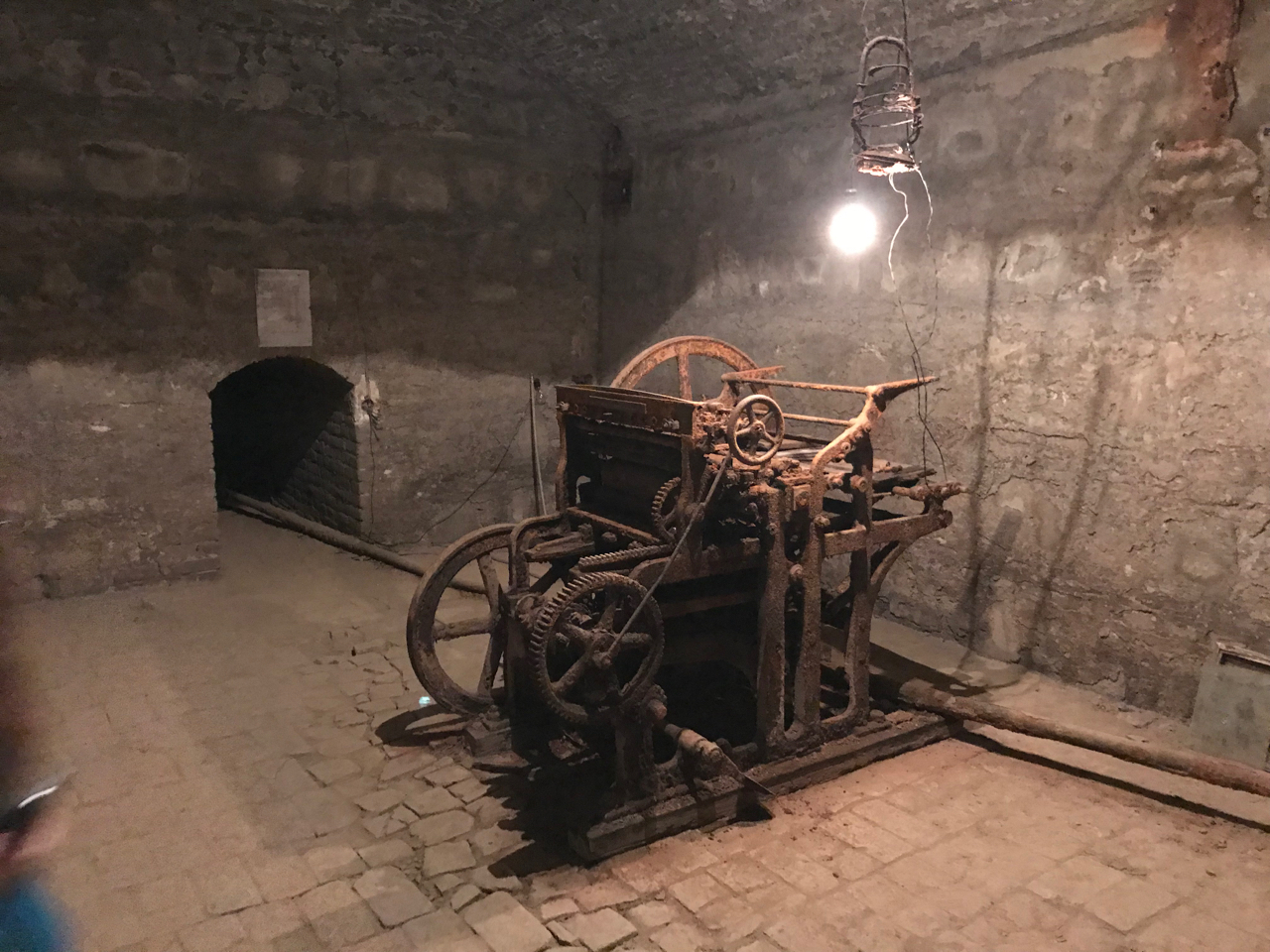 Christopher Marcisz
Christopher MarciszChristopher Marcisz

